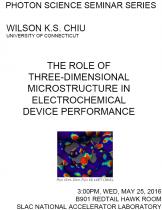Speaker: Wilson K. S. Chiu, Ph.D. (Professor)
Department of Mechanical Engineering,
University of Connecticut
Wilson K. S. Chiu earned his M.S. and Ph.D. degrees in Mechanical Engineering from Rutgers University in 1997 and 1999, respectively. His research was supported by the U.S. Department of Energy, National Science Foundation, Office of Naval Research, Army Research Office, and industry. He published 102 journal articles and 155 conference articles/abstracts. Among his honors, he was elected fellow of ASME in 2013, elected into the Connecticut Academy of Science and Engineering in 2013, received the Rutgers University School of Engineering Medal of Excellence Award for Distinguished Young Alumnus in 2010, and the United Technologies Corporation Professorship in Engineering Innovation in 2008. He is the Founding Editor of the new ASME Journal of Electrochemical Energy Conversion and Storage, and serves on the editorial board of Scientific Reports. He has given over 100 plenary, keynote and invited lectures in the United States and abroad.
Program Description
Advances in materials increasingly rely on the 3-D characteristics of its microstructure and chemistry at the nanoscale. This presentation will review 3-D imaging techniques that measure microstructural properties, and discuss its influence on material function and reliability. The presentation will then focus on three-dimensional microstructural imaging methods for energy materials. The use of a novel imaging technique, synchrotron-based transmission x-ray microscopy, will be demonstrated by characterizing structural and chemical changes in fuel cell and gas separation membrane materials. Challenges and opportunities for future work will then be discussed. The goal of this research will be to obtain a scientific and engineering understanding into how micro- and nano-structure induced transport mechanisms govern performance, with a long-term goal to improve current materials and create new materials that will enable improved device performance and increased long-term reliability for advanced engineering applications.





